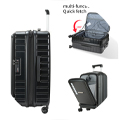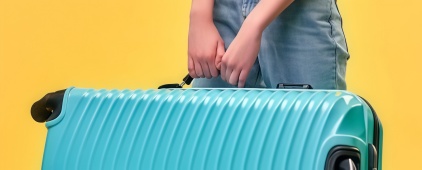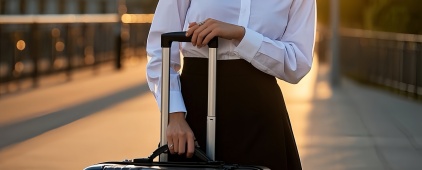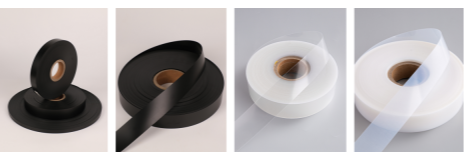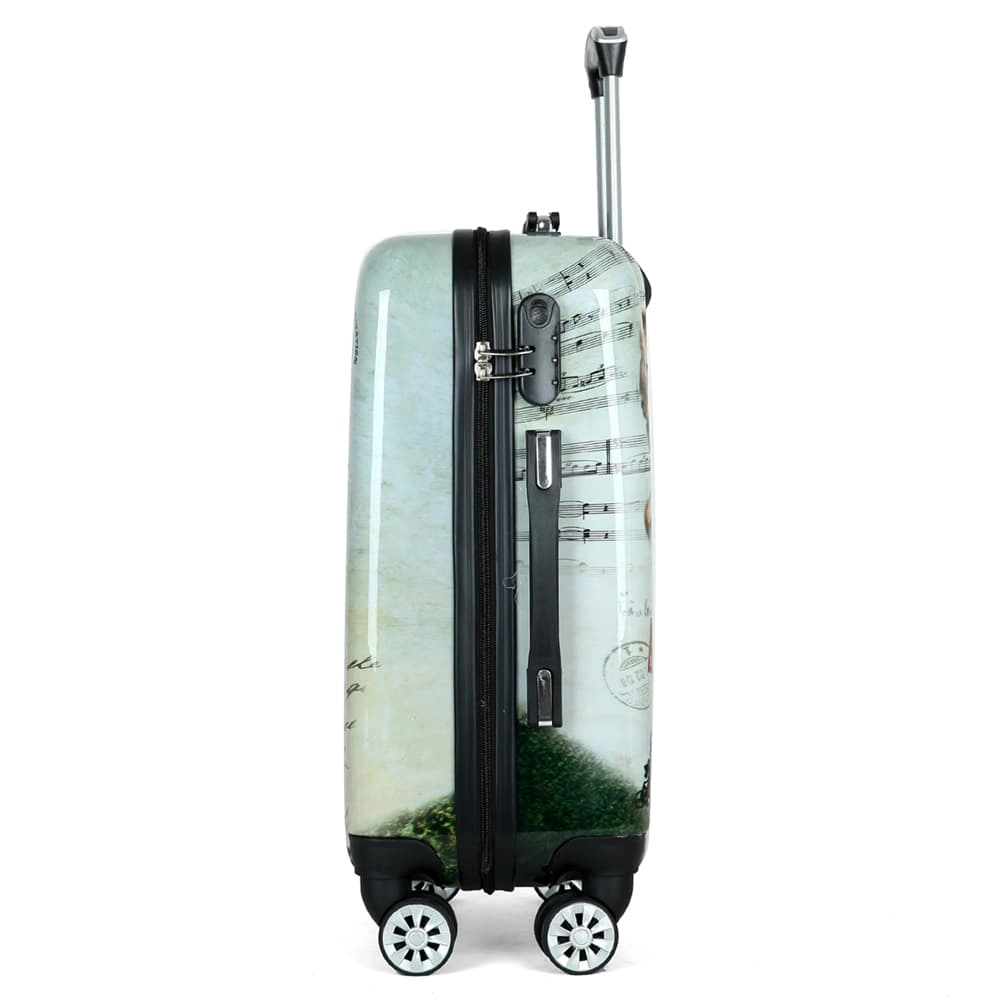Understanding Luggage Materials: Can PVC Be a Sustainable Option?
Understanding Luggage Materials: Can PVC Be a Sustainable Option?
As more people who travel look for green and strong travel items, the talk about suitcase stuff has moved toward caring for nature. Among the stuff used in suitcase making, PVC (polyvinyl chloride) shines for its cheap price and ability to keep out water. But, questions stay about if PVC suitcases can be reused and how they stack up against other stuff in terms of harm to nature. This piece looks into if PVC suitcases can be reused. It also checks its place in green travel.
What Are the Common Materials Used in Luggage Manufacturing?
Suitcase style has grown to fit current needs for strength, light weight, and duty to nature.
Overview of Traditional and Modern Luggage Materials
Old suitcases were often built from animal skin or thick cloths like rough fabric. Now, makers use many kinds of stuff. This includes polycarbonate, ABS plastic, metal like aluminum, soft fabric like polyester, strong thread like nylon, and PVC. Each kind gives special pluses based on what you need, such as work trips or fun outings.
Key Characteristics of Popular Luggage Materials
Polycarbonate is famous for its strong fight against bumps. ABS gives light and cheap choices. Nylon and polyester are picked for soft bags because of their bendy nature and hard-to-rip quality. PVC is liked for its water-proof side and low cost. But it is heavier than some other picks.
Environmental Impact of Different Luggage Fabrics
Stuff like polycarbonate and aluminum can be reused more than mixed plastics like ABS or PVC. Natural cloths might break down quicker in nature. But they often miss out on lasting power. The harm to nature depends not just on the basic stuff. It also relies on how it is made and what happens at the end when thrown away.
With uppercase, you can find a variety of travel trolley bags in different size ranges that allow you to select your ideal luggage size, while prioritising comfort, durability, and an eco-conscious design.
Pengteng knows that buyers want more than just working well. They look for items that match their beliefs. Pengteng offers a big pick of suitcase stuff. This includes green choices. By doing this, they meet the rising want for green travel fixes.
How Does PVC Compare to Other Luggage Materials?
PVC is one of the most broadly used plastics around the world. But how does it do in trip settings next to other usual stuff?
Physical Properties and Durability of PVC
PVC gives great block against water. It also has firm build. This makes it good for guarding things while moving. Yet, it can turn fragile after a while. This happens when it faces very hot or cold spots. Or when it meets strong sun rays.
Cost-Effectiveness and Manufacturing Efficiency
PVC is fairly cheap to make. This is because of set ways to build it. Its skill to be shaped into many forms makes it nice for big making.
Performance in Travel Conditions
It is not as light as polycarbonate or nylon. Still, PVC works nicely in damp places. It gives enough guard against hard treatment during moves at air fields.
Pengteng sees that PVC brings real gains like blocking water and being cheap. But its heavier side and weakness under push need careful use. This is true mainly when planning items for often use.
Is PVC a Recyclable Material in the Context of Luggage?
If any item can be reused depends on what it is made of. It also hangs on if places to reuse are there.
The Recycling Process for PVC Products
PVC can be reused through machine or chemical ways. But, added things like softeners make reusing hard. They change the basic build of the stuff.
Challenges in Recycling PVC-Based Luggage
Suitcases made from blended stuff pose extra troubles for splitting during reuse. This includes fasteners, inside covers, rollers. Dirt from non-PVC parts often makes whole items not reusable through normal city systems.
Availability of Recycling Facilities for PVC
Most nearby reuse spots do not take hard PVC. This is due to limits in handling. Special spots exist. But they are few in places. They might not be easy to reach for all buyers.
Pengteng spots these hard spots. They look for ways to make their suitcases more piece-by-piece. Or simpler to take apart. This boosts ability to reuse even when using tricky stuff like PVC.
Can PVC Be Considered an Eco-Friendly Choice for Travelers?
It is cheap and strong. Yet, if PVC is kind to nature stays argued among those who push for green ways.
Evaluating the Sustainability of PVC Production
PVC comes from oil-based roots. These need big power use during making. Plus, a chemical used in its build raises worries about bad releases if not handled right.
Long-Term Use and Waste Management Implications
It is strong enough for use over many years. So, it cuts down on buying new ones. But wrong throwing away leads to lasting plastic trash. This trash fights breaking down for many years.
Innovations in Eco-Conscious PVC Alternatives
Some makers now check bio-rooted or free-of-bad-adds kinds of PVC. These cut harm to nature. At the same time, they keep main traits like keeping out water.
Pengteng adds new stuff where it works without hurting item quality. This shows how green ways can live with great working in current suitcase plans.
What Are the Environmental Trade-Offs of Using PVC in Luggage?
Every kind of stuff comes with give-and-takes. Knowing them aids buyers in picking wisely.
Greenhouse Gas Emissions and Energy Consumption
Making fresh PVC brings higher bad gas releases than reused metals or plant cloths. This is because of need for old fuels during mixing steps.
Potential Chemical Leaching and Pollution Risks
Over time, PVC may let out chemicals into nearby spots. This is true mainly under warmth. If not treated right or thrown away at the end.
Life Cycle Assessment Compared to Other Materials
Checks of full life show that some man-made cloths give better reuse rates. Or lower release shapes than PVC. But few equal its mix of strength and water block at like prices.
Pengteng keeps checking full life effects across their item groups. They balance cheap ways with duty to nature through smarter getting of stuff.
How Are Manufacturers Addressing Sustainability with PVC?
Forward brands are rethinking how to use old plastics like PVC in a greener way.
Use of Recycled or Bio-Based PVC Materials
Some builders now put reused content into fresh items. Or shift part way to bio-PVC from growable sources like plant liquid rather than raw oil bits.
Design Strategies to Improve Recyclability
Piece build methods let easier taking apart at the end. This helps reusing at part level even when full item handling is not easy nearby.
Certifications and Industry Standards Promoting Greener Practices
Marks like REACH follow mean less bad chemical use during making. Others like ISO 14001 show wider promises toward nature handling systems in plants making suitcase items. This includes those with PVC parts.
Pengteng matches these field rules. They put money into new work aimed at mixing reused inputs. Without losing item trust. This is a ahead-thinking way liked by nature-caring people who travel around the world.
Who Is Pengteng and What Sets Them Apart in the Luggage Industry?
In a field full of picks, Pengteng stands out through new-driven making. It is based on buyer wants and green aims alike.
Pengteng’s Commitment to Quality and Innovation
Mixing high tech build with strict quality watch lets Pengteng items work steadily across different trip scenes. This includes those using tricky mixes. From quick breaks to long work trips far away.
Product Range and Material Expertise
If you seek small suitcases good for 2-3 clothes sets or big ones for holding many foot covers, 10 or more clothes sets, Pengteng uses deep know of stuff. From ABS mixes to growing forms of green plastics. They give fitted fixes across size groups set by field rules. Such as 22x14x9 inches for inside-plane bags or bigger up to 32 inches fit for long trips over 7 days.
Approach to Sustainable Product Development
By mixing piece plans with reusable parts where it can. And checking bio-other picks even in usual man-made groups like vinyl. Pengteng makes a road toward greener trip add-ons. Without giving up on working or nice looks.
Conclusion
Picking suitcases now means more than just choosing size or shade. It is also about knowing what your bag is built from. While old plastics like PVC give strength at low prices, they bring troubles about ability to reuse and safety for nature. Brands like Pengteng lead work toward greener habits. They do this by making new plan ways and stuff getting. Even when working in usual builds like polyvinyl chloride making.
FAQs
Q1: Is PVC luggage safe for long-term use?
A: Yes, when made right under rule marks (e.g., REACH follow), good PVC suitcases can give lasting strength without health dangers under usual use spots.
Q2: Can I recycle my old PVC suitcase at a local recycling center?
A: Most nearby spots do not take hard multi-stuff items like suitcases due to split troubles. Special spots may be needed based on where you are.
Q3: Are there more eco-friendly alternatives to PVC luggage?
A: Yes. Picks include reused PET cloth bags or polycarbonate covers made using after-use trash flows. Some brands also check bio-based plastics from growable sources.


